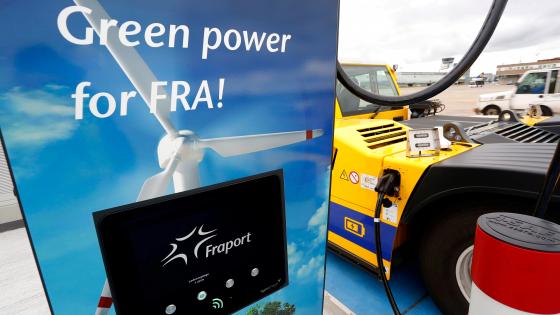Supported by the German Ministry for Economic Affairs and Climate Action, Fraport is turning its electric vehicles into mobile power storage units.
Airport operator Fraport is gradually converting its fleet of vehicles to electric drives. Parallel to this, the charging infrastructure at Germany’s largest air traffic hub – Frankfurt International Airport – is also expanding and evolving.
The infrastructure still works conventionally, with current flowing from a charging point into vehicles’ storage batteries. In the future, however, power will also be supplied in the opposite direction. This approach will turn e-vehicles into mobile storage units that are able to feed unused power back into the grid on an as-needed basis. The technology isn’t yet ready for large-scale use, however, and the interfaces also still need to be standardised, Fraport said. This applies in particular to many of the special-purpose vehicles used for aircraft ground handling.
By 2045 at the latest, the Fraport Group will achieve zero carbon operation
Fraport is receiving support from the German Ministry for Economic Affairs and Climate Action for broadly implementing this ambitious idea at the airport. Over the next four years, more than €5m will flow to Frankfurt Airport as part of Germany’s programme to promote electromobility. Fraport itself, together with other partners, will invest another €4.1m in the project.
“Frankfurt Airport is providing an ideal, self-contained field test system for implementing a bidirectional charging infrastructure,” said Michael Kuschel, the Fraport vice president responsible for power and networks. “Fraport is playing all of the main roles in it: we are both the network operator and its primary consumer. The charging points are part of our own infrastructure, and we are also providing the required software. This unique constellation enables us to model the required test environment despite the fact that not all of the technical and regulatory definitions have been fully formulated yet.”
Also involved in the project are Stromnetz Hamburg (the owner and operator of Hamburg’s power distribution network), which will support Fraport in developing the required software, and the Darmstadt University of Applied Sciences, which will be monitoring the economic and technical aspects. The German Ministry for Economic Affairs and Climate Action has put the DLR German Aerospace Center in charge of the project.
The aim of the project
“By the year 2045 at the latest, the Fraport Group will achieve zero carbon operation,” said Kuschel. “Within the scope of our decarbonisation strategy, over the years ahead we’ll mainly be focusing on wind and solar energy. This means that in the future, depending on how much power is generated and consumed at any given moment, sometimes there will be too little or too much in the network. It’s impossible to precisely predict either our actual needs or the availability of renewable energy. So we have to develop a system that will let us flexibly and autonomously manage their fluctuations. One of the keys for accomplishing this is intermediate storage.”
Fraport currently has a fleet of about 650 electrically powered vehicles and is planning to add another 600 cars, buses, and dedicated ground handling vehicles with electric drives by 2026. With the aid of bidirectional charging equipment, the storage batteries of this motor pool will collectively constitute a large-scale virtual reservoir able to accept and provide constantly changing amounts of electric power. Controlled by sophisticated software, it will manage supply and demand without negatively impacting everyday operations at Frankfurt Airport.

Frankfurt Airport offers a self-contained field test system for implementing bidirectional charging infrastructure
“Fraport’s long-term goal is to introduce bidirectional charging throughout the airport while taking the wide variety of vehicle types used into account,” said Kuschel. “An airport operates critical infrastructure, which makes it essential to consistently ensure a stable network and dependable power supply. This is a major challenge, but once it has been successfully mastered the system will crucially strengthen the airport. It will also provide attractive economic benefits, since we expect that this migration will also allow us to reduce our expenditures for electric power by making efficient use of available resources.”
Slated to last four years, the project will kick off with a 12-month technical planning phase. Over the next three years, nearly 90 bidirectional charging points to be installed at the airport.
Impact on public infrastructure
Bidirectional charging can potentially be extended to other, externally used infrastructure at Frankfurt Airport, such as parking facilities. The project also includes appropriate transfer concepts and business models for the public realm. “We see good potential for integrating this innovative technology to manage power supply and demand elsewhere and fully tap its economic potential,” said Claus Grunow, Fraport’s vice president for corporate strategy and digitalisation.
Images: Fraport
